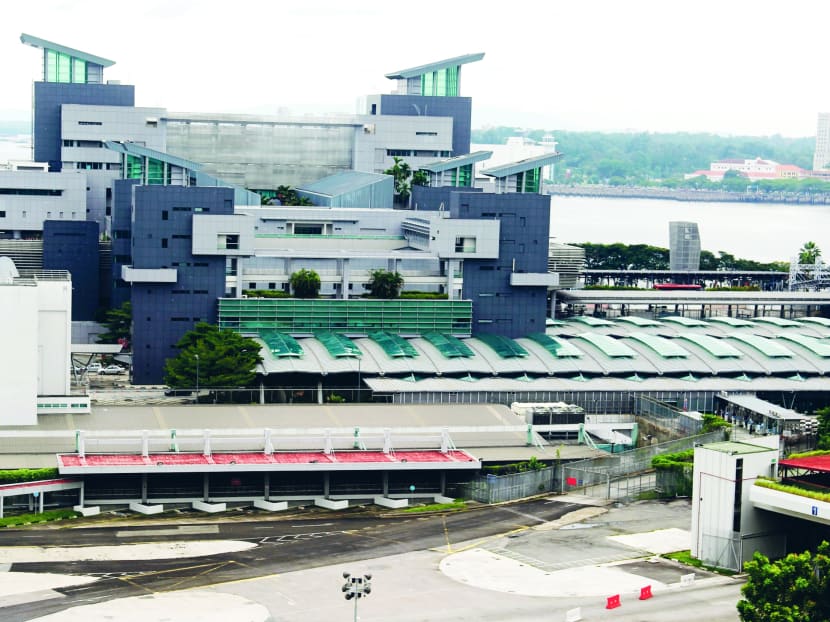Mobile crash barriers, tracking vehicles to beef up Woodlands security
SINGAPORE — Mobile crash barriers and tracking vehicles will be deployed at the Woodlands Checkpoint as “additional lines of defence” against motorists trying to dodge checkpoint security, said Deputy Prime Minister and Minister for Home Affairs Teo Chee Hean in Parliament yesterday.

Woodlands Checkpoint. Photo: Ernest Chua
SINGAPORE — Mobile crash barriers and tracking vehicles will be deployed at the Woodlands Checkpoint as “additional lines of defence” against motorists trying to dodge checkpoint security, said Deputy Prime Minister and Minister for Home Affairs Teo Chee Hean in Parliament yesterday.
But while steps are being taken to beef up security after two high-profile immigration breaches at the checkpoint this year, efforts are also being made to improve the clearance process for the thousands of motorists who go through the checkpoints each day, striking a balance between speedy clearance and tight security.
Responding to questions from Members of Parliament on the breaches that captured public attention earlier this year, Mr Teo shed light on the incident last month, when Tan Chu Seng, a Malaysian delivery driver, managed to drive off in his Singapore-registered car while undergoing security checks, sparking a five-hour search before he was arrested. Security barriers were activated to stop him, but Tan had managed to drive over them.
Less than two months before that, a Malaysian woman — later declared to be of unsound mind — slipped past immigration by tailgating another car and stayed in Singapore for three days before she was arrested.
Yesterday, Mr Teo said investigations revealed that the security barrier had failed to stop Tan’s car because hydraulic fluid had leaked from one of the cylinder seals that raise and maintain the barrier’s position.
The Immigration and Checkpoints Authority (ICA) is replacing the hydraulic components in the security barriers and will be conducting daily checks to ensure they function properly. Previously, these barriers were checked and serviced every three months. They were last serviced a month before the incident.
Mr Teo also acknowledged that the five hours the authorities had taken to arrest Tan was “too long” and security lapses are being “looked at”. However, he also noted that the police, having identified Tan within a “very short time”, were able to track him “quite closely” after that. “And very early on, the police were able to come to an assessment that in this case, he was not likely to be a terrorist,” Mr Teo said.
A ministry-level review committee, comprising senior representatives from the ICA, the police and other Home Team agencies, has been formed to review security measures at the checkpoints and identify any systemic issues.
“If there are gaps and failings in our security regime, be they structural, systemic or individual, we must quickly and thoroughly address them,” Mr Teo said.
Meanwhile, security measures such as installing additional closed-circuit television cameras and enhanced security barriers are being expedited, he added.
When asked if manpower recruitment posed an issue on the ground, Mr Teo replied that the issues faced were “infrastructural ones”. The checkpoints were built some time ago and space is “tight”. Thus, many of the security measures that have been introduced into the existing infrastructure have resulted in some delays to the clearance of vehicles, particularly through the checkpoints, said Mr Teo.
“The two breaches show the scale and complexity of the checkpoint operations. This requires a team of officers able to carry out robust and effective measures to prevent and deal with a wide range of threats, including attempts to get through the primary or subsequent layers of security at our checkpoints,” he said.
“At the same time, our land checkpoints must facilitate the swift and secure clearance of people and goods. Finding the right balance is not easy.”
The Ministry of Home Affairs said four additional immigration counters for lorries and 20 additional counters for motorcycles were added in 2008 and 2009 respectively. By 2016, 30 car counters will be added. Presently, ICA opens up to 20 car counters during peak periods, Sundays and public holidays.
The ICA will continue to channel more passengers and vehicles towards self-clearance modes, such as the biometric self-clearance system being used by about 30 per cent of the 70,000 motorcycles passing through daily.
All Work Permit and S-Pass holders will be automatically enrolled into the ICA’s automatic clearance system by the middle of this year, which would make 95 per cent of all Malaysian motorcycle trips eligible for automatic clearance.
“So what this will do is help speed up the clearance of motorcycles and reduce the queues of motorcycles and therefore open up some of the existing capacity for other vehicles,” Mr Teo said. “And again, this will help us strike a balance between speedy clearance and tight security.”






